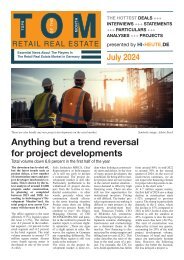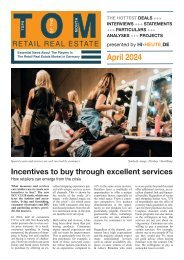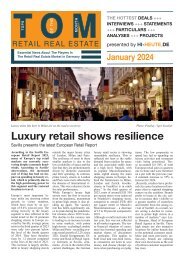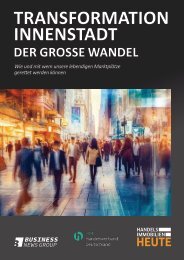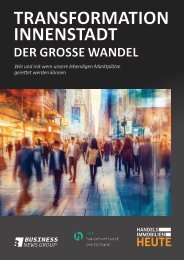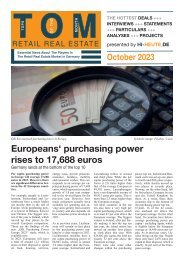Create successful ePaper yourself
Turn your PDF publications into a flip-book with our unique Google optimized e-Paper software.
Page 11 NEWS December <strong>2023</strong><br />
On the way to an urban commercial district<br />
Interview with Steffen Uttich and Fabian Spahn (INBRIGHT Investment)<br />
Shopping centers remain attractive<br />
for investors if they<br />
move away from the retail<br />
monoculture. This is what<br />
Steffen Uttich (Managing Director)<br />
and Fabian Spohn (Senior<br />
Portfolio Manager) from<br />
INBRIGHT Investment say<br />
in a <strong>TOM</strong> double interview.<br />
Their Berlin-based company<br />
focuses on light industrial real<br />
estate in economically strong<br />
regions throughout Germany.<br />
<strong>TOM</strong>: How has the world of<br />
institutional real estate investors<br />
developed? Things looked<br />
very different 20 years ago,<br />
didn‘t they?<br />
Steffen Uttich/Fabian Spohn:<br />
Indeed. Back then, the world<br />
of German institutional real<br />
estate investors was a world of<br />
drawers: Drawer open, type of<br />
use in, drawer closed. The portfolio<br />
cabinet was then sorted<br />
according to residential, office,<br />
retail and hotel. Sometimes it<br />
even contained something as<br />
exotic as logistics. In any case,<br />
a mixture was not intended at<br />
property level. Preferably one<br />
tenant with one use in one building<br />
- that made the investment<br />
clear. The weighting of the individual<br />
types of use at portfolio<br />
level was a strategic decision<br />
that investors wanted to make<br />
themselves.<br />
This approach was no longer<br />
up to date, at the latest with the<br />
upheavals that the 2008 financial<br />
crisis brought to the real<br />
estate market. The miracle of<br />
risk diversification slowly but<br />
steadily found its way from securities<br />
investments to real estate<br />
investments. After all, it is the<br />
individual property that ultimately<br />
determines the success of an<br />
investment. And that is why risk<br />
diversification should start right<br />
there. Risk diversification in<br />
real estate investment therefore<br />
means bringing many tenants<br />
with different types of use under<br />
one roof. Multi-tenant/multi-use<br />
is the recipe for success that requires<br />
two essential ingredients:<br />
space that can be used by third<br />
parties and a property manager<br />
who can deal with many tenants<br />
and different types of use. As<br />
a result, the investor gets what<br />
he expects: stable rental income<br />
and thus a stable return on his<br />
invested capital.<br />
Steffen Uttich und Fabian Spohn Fotos: INBRIGHT<br />
<strong>TOM</strong>: What will the medium-term<br />
future hold for investors?<br />
Steffen Uttich/Fabian Spohn:<br />
It is precisely this miracle of<br />
risk diversification that can save<br />
many inner-city shopping centers<br />
their status as an established<br />
investment property for institutional<br />
investors in the coming<br />
years. Of course, there will also<br />
be shopping centers in the future<br />
that will continue to function<br />
due to their location and<br />
reputation with a high customer<br />
frequency. But these will be few<br />
and far between. The majority<br />
will no longer be able to cope<br />
with the challenges posed by<br />
online retail and changing consumer<br />
habits. For their current<br />
owners, they need to reinvent<br />
their shopping centers.<br />
That sounds more difficult than<br />
it is. Because there are actually<br />
only two adjustments that need<br />
to be made. The first is to open<br />
up the shopping center space -<br />
including the sometimes oversized<br />
parking areas - for other<br />
types of use. Instead of the monoculture<br />
of retail with a fig leaf<br />
of gastronomy, a colorful quarter<br />
can be created in which the<br />
original tenant target audience<br />
occupies at most half or less of<br />
the current space. The rest can<br />
be filled by city logistics companies,<br />
craftsmen with their workshops,<br />
educational institutions,<br />
medical professionals with laboratories<br />
and, last but not least,<br />
creative companies.<br />
Such a property strategy can<br />
open up undreamt-of potential.<br />
For example, it can be assumed<br />
that the neighboring districts<br />
will be revitalized by combining<br />
workplaces and residential<br />
areas. Horizontal integration<br />
makes it possible to implement<br />
flexible working time and family<br />
concepts without long commuting<br />
times. At the same time,<br />
the other types of use can generate<br />
new public traffic, which<br />
revitalizes the retail and restaurant<br />
areas and generates the necessary<br />
turnover. This approach<br />
can already be seen in Bochum,<br />
where a virtue is being made of<br />
necessity with the establishment<br />
of urban production. Today‘s<br />
shopping centers can play a central<br />
role in such a concept if they<br />
combine the production and sale<br />
of locally manufactured goods<br />
under one roof.<br />
<strong>TOM</strong>: What is the major challenge<br />
in the repurposing process?<br />
Steffen Uttich/Fabian Spohn:<br />
The trick is to make this transformation<br />
into a multi-tenant/<br />
multi-use property economically<br />
viable. However, in view of<br />
the ongoing price correction in<br />
the shopping center segment,<br />
business plans are likely to provide<br />
more and more scope for<br />
this. A leased multi-use center<br />
can continue to generate attractive<br />
returns for investors, even if<br />
the rental income is at a lower<br />
level than in the original use. For<br />
example, the resulting ancillary<br />
costs, which would otherwise<br />
have to be borne by the landlord,<br />
fall with the vacancy. If<br />
the downward spiral of vacancy<br />
and inadequate footfall is interrupted<br />
by a new mix of uses, the<br />
benefits increase. If, for example,<br />
rents of EUR 15 per square<br />
meter are consistently generated<br />
for a year in a center with<br />
a variety of uses, this is more<br />
profitable than a vacancy of six<br />
months in a space rented for an<br />
average of EUR 30 per square<br />
meter. If high-quality services<br />
such as doctors and laboratories<br />
can be located, an even higher<br />
rent level can be expected. If the<br />
fit-out of the multi-use space is<br />
also geared towards the highest<br />
possible third-party usability,<br />
the costs for future meter extensions<br />
can be set lower - leaving<br />
more scope for the retail space<br />
that is desired to remain in the<br />
center. There are also positive<br />
effects for sustainability, financing,<br />
valuation and exit price.<br />
<strong>TOM</strong>: And what else is important<br />
in this context?<br />
Steffen Uttich/Fabian Spohn:<br />
Above all, property management.<br />
Successful asset and property<br />
management of shopping<br />
centers has always been an art<br />
in its own right. Striking the<br />
right balance between the right<br />
mix of stores and the maximum<br />
achievable rents with the lowest<br />
possible vacancy rate is a smart<br />
business. But it is a business of<br />
yesterday. Developing an understanding<br />
that new skills are<br />
needed here can prove to be a<br />
major hurdle. In place of the<br />
previous retail letting artist, the<br />
skills of a community manager<br />
are required who can adapt to<br />
the particularities of very different<br />
users.<br />
As in a traditional business<br />
park, it is important to keep an<br />
eye on the needs of the tenants<br />
at all times, provide ideal space<br />
for the respective purposes and<br />
respond to changes in operations<br />
during the rental period.<br />
When it comes to re-letting, it is<br />
important to deal appropriately<br />
with prospective tenants beyond<br />
the highly professionalized expansion<br />
departments from the<br />
retail sector. A number of lessons<br />
can be learned here from<br />
the operation of co-working<br />
spaces, especially from the light<br />
industrial market segment. It<br />
would therefore come as no great<br />
surprise if light industrial specialists,<br />
with their experience in<br />
managing different types of use,<br />
were soon to find themselves<br />
in the shopping center market.



